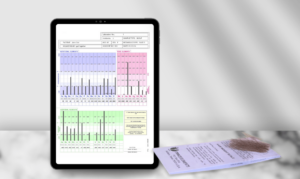Is your Iron Actually Low?
The Iron Conundrum
Iron deficiency is a common concern, especially for those experiencing symptoms like chronic fatigue, hair loss, and cold intolerance. Many individuals are told they have low iron or low ferritin (the stored form of iron) based on blood work results and are quickly prescribed iron supplements. But what if low iron levels aren’t always what they seem? In some cases, the issue isn’t a lack of iron but rather an imbalance in the iron recycling system or iron being trapped in the wrong places in the body. Here’s a closer look at why this happens, how we can use HTMA and blood work together to get a fuller picture, and what key nutrients are essential for proper iron regulation.
The Iron Recycling System: More Than Just Iron
Iron metabolism is a complex system that relies on the interplay of multiple nutrients, each playing a critical role in how iron is absorbed, utilized, and recycled in the body. Here are some key players:
- Copper: Copper is essential for the function of ceruloplasmin, a protein that helps transport iron out of storage and make it available for use. Without adequate copper, iron can become trapped in storage, leading to symptoms of deficiency despite iron being present in the body.
- Ceruloplasmin: This copper-containing enzyme helps mobilize iron from storage sites, particularly the liver, and allows it to be properly used by the body. Low ceruloplasmin can result in iron getting “stuck” and unable to be used effectively.
- Zinc: Zinc plays a role in the balance of copper and is necessary for overall immune function. However, an excess of zinc can interfere with copper levels, which in turn can disrupt iron mobilization. The right balance between zinc and copper is crucial for maintaining iron levels.
- Vitamin C: Known for enhancing iron absorption, vitamin C helps convert ferric iron (Fe3+) into the more absorbable ferrous iron (Fe2+). It also supports the immune system and aids in reducing oxidative stress, which is important in maintaining healthy iron levels.
- Vitamin A: Vitamin A works synergistically with iron, aiding in the release of iron from storage and improving hemoglobin synthesis. It also supports the overall health of the gut lining, where iron absorption takes place, making it a critical component for those struggling with low iron levels.
How HTMA and Blood Work Can Help Us Understand Iron Imbalance
Blood work and HTMA (Hair Tissue Mineral Analysis) can be used together to provide a deeper understanding of mineral imbalances that impact iron status:
Blood Work: Blood tests such as serum ferritin, hemoglobin, iron, and Total Iron-Binding Capacity (TIBC) give an indication of the amount of iron in circulation and in storage. However, they don’t always show how well the body is actually using that iron.
What we are looking at on blood work:
- Ceruloplasmin: A protein that carries copper in the blood and plays a key role in converting stored iron into a form that can be used by the body. Low ceruloplasmin levels can indicate a lack of bioavailable copper, potentially leading to iron being stored but not properly utilized.
- Copper: Essential for iron metabolism, copper is a cofactor for ceruloplasmin. Low copper levels can impair iron mobilization, even if stored iron is available. High copper can sometimes indicate a compensatory response to inflammation or imbalance with zinc.
- Hemoglobin: A protein in red blood cells that carries oxygen. Low hemoglobin often suggests anemia, which can be related to low iron, but also to other factors like deficiencies in B12, folate, or chronic disease. Normal hemoglobin does not always rule out low iron stores.
- Iron (Serum Iron): Measures the amount of circulating iron in the blood. Low levels can indicate insufficient iron intake or absorption, while high levels can point to conditions like iron overload or chronic inflammation, where iron is stuck in circulation but not effectively used.
- Total Iron-Binding Capacity (TIBC): Indicates the capacity of the blood to bind iron with transferrin, the protein that carries iron. A high TIBC can suggest that the body is actively searching for more iron, often correlating with low iron stores, while low TIBC might indicate that there’s enough iron but the body isn’t utilizing it effectively, possibly due to liver issues.
- Ferritin: Reflects the body’s stored iron. Low ferritin is a marker of depleted iron stores and often the first sign of iron deficiency. Elevated ferritin can indicate inflammation or iron overload, making it important to consider alongside other markers.
- Magnesium, RBC (Red Blood Cell Magnesium): Magnesium is vital for many enzyme functions, including those involved in iron metabolism. Low magnesium can impair the absorption and transport of iron, contributing to anemia. RBC magnesium is often a better indicator of long-term magnesium status than serum magnesium.
- Transferrin: The main protein that binds to iron and transports it through the blood. Low transferrin levels might indicate malnutrition or liver disease, while high levels can suggest that the body is trying to compensate for low iron stores.
- Vitamin A: Essential for the mobilization of iron from storage and the synthesis of red blood cells. Vitamin A deficiency can impair iron metabolism and lead to symptoms of anemia, even if iron intake is adequate.
- Vitamin D, 25-Hydroxy: While not directly related to iron metabolism, vitamin D is crucial for overall immune function and inflammation regulation, which can impact how the body manages iron. Low vitamin D can correlate with inflammation, affecting how iron is stored and used.
- Zinc: Zinc plays a role in immune function and interacts with copper in a balanced relationship. High zinc levels can suppress copper absorption, which in turn can impact iron metabolism and contribute to hidden iron issues. On the other hand, low zinc can also be problematic for overall cellular health and enzyme function.
Key HTMA Markers for Iron Status and Mineral Balance
HTMA: An HTMA can reveal patterns of mineral imbalances that may contribute to iron issues, like low copper or elevated zinc, which might be inhibiting iron transport. HTMA can also show if a client is in a “high iron burn rate” state, where minerals like sodium and potassium are low, pointing to an increased need for support in other areas.
What we’re looking at on HTMA:
Copper: HTMA can indicate how copper is being utilized over time. High copper levels in the hair may suggest an inability to properly use copper in the body, often seen when the liver is overburdened. Even if copper appears high, it can indicate that it is “buried” and not bioavailable, meaning that it needs to be mobilized and made usable for the body’s processes, including supporting iron metabolism. Low hair copper can indicate a deficiency, which can impair iron mobilization.
Iron: While not always as precise as blood tests for measuring circulating iron, HTMA can reveal trends in iron status over a longer period. High hair iron may indicate poor detoxification pathways or excess iron that the body is trying to excrete, while low levels can reflect a chronic deficiency or poor absorption.
Zinc: HTMA helps to identify whether zinc levels are high or low over time. This can give clues about how zinc is interacting with copper and affecting iron metabolism. Low hair zinc can indicate a deficiency, while high levels can point to a zinc-copper imbalance.
Magnesium: HTMA offers insight into magnesium levels over time, showing if the body is burning through magnesium quickly, which can impact other minerals like iron. A low magnesium level in the hair can indicate chronic stress and nutrient depletion, affecting overall mineral absorption.
Heavy Metals: The presence of heavy metals like lead, mercury, or cadmium in HTMA can indicate a toxic burden that competes with nutrient minerals like iron, zinc, and copper. Heavy metal toxicity can impair the body’s ability to properly use and metabolize these essential minerals, contributing to hidden or functional iron imbalances.
Case Study: When Low Iron Isn’t What It Seems
Client Profile: Sarah, a 35-year-old woman, came to us after years of being told her ferritin levels were too low. Despite taking iron supplements at various doses, she still experienced fatigue, hair thinning, and cold extremities. She had also been prescribed iron infusions, yet her symptoms persisted and ferritin remained low.
What We Found: Upon reviewing her blood work, we saw that her serum iron and ferritin levels were indeed low, but her Total Iron-Binding Capacity (TIBC) was high, indicating her body was searching for iron. We decided to run an HTMA to assess underlying mineral imbalances. Her HTMA results revealed low levels of copper,, indicating that while she had iron in storage, her body wasn’t able to mobilize it effectively.
The Approach: We shifted the focus away from more iron supplementation and instead worked on increasing her copper intake through copper-rich foods and supplements. We also added a well-balanced multivitamin with vitamin A and vitamin C to support her overall iron metabolism. Within a few months, Sarah’s ferritin levels stabilized, her fatigue improved, and she no longer experienced the constant cold sensation in her hands and feet.
The Potential Dangers Of Iron Supplementation
Supplementing with iron when it isn’t truly needed can have serious implications. Excess iron in the body can act as a pro-oxidant, meaning it can promote oxidative stress and inflammation, which can damage tissues and cells. This can contribute to conditions like insulin resistance, liver stress, and cardiovascular issues. Additionally, when iron levels are artificially elevated through supplementation without addressing underlying issues—such as copper imbalance or poor iron recycling—iron can get stored in tissues rather than being properly utilized. This storage can cause symptoms of iron overload, even if blood iron appears normal. It’s essential to determine whether the body is truly iron-deficient or if other minerals like copper and zinc are out of balance, impacting iron utilization. This is why both blood work and HTMA are valuable tools for understanding the full picture before deciding on iron supplementation.
Why Addressing the Root Cause Matters
Sarah’s case is a reminder that throwing iron at the problem is not always the solution. Understanding the bigger picture and the role of minerals like copper, zinc, and ceruloplasmin in iron regulation is essential. Using both HTMA and blood work, we were able to identify the true cause of her symptoms and create a plan that supported her body’s natural processes.
Conclusion: Don’t Take Iron At Face Value
Managing iron levels requires more than just a straightforward approach. By evaluating the entire mineral landscape through HTMA and blood work, we can address hidden factors that might be impacting iron status. For those struggling with chronic low iron, consider looking beyond traditional iron supplementation and exploring the mineral imbalances that could be holding you back from optimal health.
Ready to start supporting your minerals? Download my free mineral guide to get started on understanding the foundational role of minerals in your health journey!









